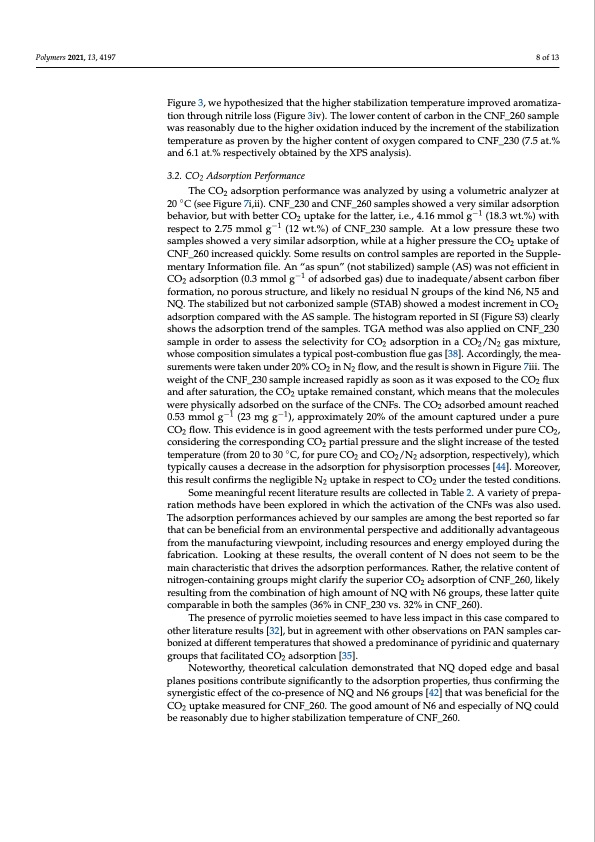
PDF Publication Title:
Text from PDF Page: 008
Polymers 2021, 13, 4197 8 of 13 Figure 3, we hypothesized that the higher stabilization temperature improved aromatiza- tion through nitrile loss (Figure 3iv). The lower content of carbon in the CNF_260 sample was reasonably due to the higher oxidation induced by the increment of the stabilization temperature as proven by the higher content of oxygen compared to CNF_230 (7.5 at.% and 6.1 at.% respectively obtained by the XPS analysis). 3.2. CO2 Adsorption Performance The CO2 adsorption performance was analyzed by using a volumetric analyzer at 20 ◦C (see Figure 7i,ii). CNF_230 and CNF_260 samples showed a very similar adsorption behavior, but with better CO2 uptake for the latter, i.e., 4.16 mmol g−1 (18.3 wt.%) with respect to 2.75 mmol g−1 (12 wt.%) of CNF_230 sample. At a low pressure these two samples showed a very similar adsorption, while at a higher pressure the CO2 uptake of CNF_260 increased quickly. Some results on control samples are reported in the Supple- mentary Information file. An “as spun” (not stabilized) sample (AS) was not efficient in CO2 adsorption (0.3 mmol g−1 of adsorbed gas) due to inadequate/absent carbon fiber formation, no porous structure, and likely no residual N groups of the kind N6, N5 and NQ. The stabilized but not carbonized sample (STAB) showed a modest increment in CO2 adsorption compared with the AS sample. The histogram reported in SI (Figure S3) clearly shows the adsorption trend of the samples. TGA method was also applied on CNF_230 sample in order to assess the selectivity for CO2 adsorption in a CO2/N2 gas mixture, whose composition simulates a typical post-combustion flue gas [38]. Accordingly, the mea- surements were taken under 20% CO2 in N2 flow, and the result is shown in Figure 7iii. The weight of the CNF_230 sample increased rapidly as soon as it was exposed to the CO2 flux and after saturation, the CO2 uptake remained constant, which means that the molecules were physically adsorbed on the surface of the CNFs. The CO2 adsorbed amount reached 0.53 mmol g−1 (23 mg g−1), approximately 20% of the amount captured under a pure CO2 flow. This evidence is in good agreement with the tests performed under pure CO2, considering the corresponding CO2 partial pressure and the slight increase of the tested temperature (from 20 to 30 ◦C, for pure CO2 and CO2/N2 adsorption, respectively), which typically causes a decrease in the adsorption for physisorption processes [44]. Moreover, this result confirms the negligible N2 uptake in respect to CO2 under the tested conditions. Some meaningful recent literature results are collected in Table 2. A variety of prepa- ration methods have been explored in which the activation of the CNFs was also used. The adsorption performances achieved by our samples are among the best reported so far that can be beneficial from an environmental perspective and additionally advantageous from the manufacturing viewpoint, including resources and energy employed during the fabrication. Looking at these results, the overall content of N does not seem to be the main characteristic that drives the adsorption performances. Rather, the relative content of nitrogen-containing groups might clarify the superior CO2 adsorption of CNF_260, likely resulting from the combination of high amount of NQ with N6 groups, these latter quite comparable in both the samples (36% in CNF_230 vs. 32% in CNF_260). The presence of pyrrolic moieties seemed to have less impact in this case compared to other literature results [32], but in agreement with other observations on PAN samples car- bonized at different temperatures that showed a predominance of pyridinic and quaternary groups that facilitated CO2 adsorption [35]. Noteworthy, theoretical calculation demonstrated that NQ doped edge and basal planes positions contribute significantly to the adsorption properties, thus confirming the synergistic effect of the co-presence of NQ and N6 groups [42] that was beneficial for the CO2 uptake measured for CNF_260. The good amount of N6 and especially of NQ could be reasonably due to higher stabilization temperature of CNF_260.PDF Image | Effect of Thermal Stabilization on PAN-Derived Electrospun Carbon Nanofibers

PDF Search Title:
Effect of Thermal Stabilization on PAN-Derived Electrospun Carbon NanofibersOriginal File Name Searched:
polymers-13-04197-v2.pdfDIY PDF Search: Google It | Yahoo | Bing
Sulfur Deposition on Carbon Nanofibers using Supercritical CO2 Sulfur Deposition on Carbon Nanofibers using Supercritical CO2. Gamma sulfur also known as mother of pearl sulfur and nacreous sulfur... More Info
CO2 Organic Rankine Cycle Experimenter Platform The supercritical CO2 phase change system is both a heat pump and organic rankine cycle which can be used for those purposes and as a supercritical extractor for advanced subcritical and supercritical extraction technology. Uses include producing nanoparticles, precious metal CO2 extraction, lithium battery recycling, and other applications... More Info
| CONTACT TEL: 608-238-6001 Email: greg@infinityturbine.com | RSS | AMP |